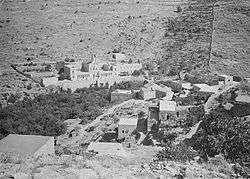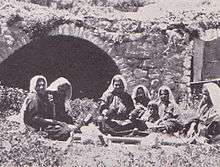Artas, Bethlehem
| Artas | |
|---|---|
| Other transcription(s) | |
| • Arabic | أرطاس |
|
Artas, Convent of the Hortus Conclusus | |
 Artas Location of Artas within the Palestinian territories | |
| Coordinates: 31°41′21″N 35°11′10″E / 31.68917°N 35.18611°ECoordinates: 31°41′21″N 35°11′10″E / 31.68917°N 35.18611°E | |
| Palestine grid | 167/121 |
| Governorate | Bethlehem |
| Government | |
| • Type | Village council |
| • Head of Municipality | Hamdi Aish |
| Area | |
| • Jurisdiction | 4,304 dunams (4.3 km2 or 1.7 sq mi) |
| Population (2007) | |
| • Jurisdiction | 3,663 |
| Name meaning | Urtas, p.n.[1] |
Artas (Arabic: أرطاس) is a Palestinian village located four kilometers southwest of Bethlehem in the Bethlehem Governorate in the central West Bank. According to the Palestinian Central Bureau of Statistics, the town had a population of 3,663 in 2007.[2]
Etymology
According to le Strange, the name Urtas is probably a corruption of Hortus, which has the same meaning as Firdus (Paradise),[3] while Edward Henry Palmer thought it was a personal name.[1] The name might also be derived from Latin hortus meaning garden, hence the name Hortus Conclusus of the nearby Catholic Convent.
Geography
Artas and the surrounding area is characterized by the diversity of landscapes, flora and fauna due to its location at a meeting place of ecosystems.[4] From a spring below the village an aqueduct used to carry water to Birket el Hummam by Jebel el Fureidis.[5]
History
Fatimid to Mamluk periods
According to Moshe Sharon, professor of early Islamic history at Hebrew University, two inscriptions found in the village show the great interest in Artas from leaders in the Fatimid and Mamluk states, as well as the wealth of the village at that time.[6]
Nasir Khusraw (1004-1088) wrote that "a couple of leagues from Jerusalem is a place where there are four villages, and there is here a spring of water, with numerous gardens and orchards, and it is called Faradis (or the Paradises), on account of the beauty of the spot."[3]
During the Crusader period, the village was known as Artasium, or Iardium Aschas. In 1227, Pope Gregory IX confirmed that the village had been given to the Church of Bethlehem.[7] Remains of the Crusader church were torn down in the 19th century.[8]
Ottoman period

The village was incorporated into the Ottoman Empire in 1517 with all of Palestine, and in 1596 it appeared in the tax registers as being in the Nahiya of Quds of the Liwa of Quds. It had a population of 32 Muslim households.[9]
Until the 19th century, the Artas residents were responsible for guarding Solomon's Pools, a water system conducting water to Bethlehem, Herodium, and the Temple Mount or Haram al-Sharif in Jerusalem. The village had a tradition of hosting foreign and local scholars, not a few of whom were women.[10] As a result, there is a great body of work on all aspects of the village,[11]
In the mid-19th century, James Finn, the British Consul of Jerusalem (1846-1863),[12] and his wife Elisabeth Ann Finn, bought land in Artas to establish an experimental farm where they planned to employ poverty-stricken Jews from the Old City of Jerusalem. Johann Gros Steinbeck (grandfather of the author John Steinbeck) and his brother Friedrich, settled there under the leadership of John Meshullam, a converted Jew and member of a British missionary society.[13] Clorinda S. Minor also lived in Artas in 1851 and 1853.
The French explorer Victor Guérin visited the area in July 1863,[14] and he described the village to have about 300 inhabitants. Many of the village houses appeared to be built of ancient materials.[15] An official Ottoman village list from about 1870 showed that Artas had 18 houses and a population of 60, though the population count included only men.[16]
In 1883, the Palestine Exploration Fund's Survey of Western Palestine described Artas as "a small village perched against hill-side...with a good spring behind it whence an acqueduct led to Jebel Furedis...remains of a reservoir Humman Suleiman."[17]
British Mandate

The Finnish anthropologist Hilma Granqvist came to Artas in the 1920s as part of her research on the women of the Old Testament. She "arrived in Palestine in order to find the Jewish ancestors of Scripture. What she found instead was a Palestinian people with a distinct culture and way of life. She therefore changed the focus of her research to a full investigation of the customs, habits and ways of thinking of the people of that village. Granqvist ended up staying till 1931 documenting all aspects of village life. In so doing she took hundreds of photographs."[18] Her many books about Artas were published between 1931 and 1965, making Artas one of the best documented Palestinian villages.

In the 1922 census of Palestine, conducted by the British Mandate authorities, "Urtas" had a population of 433, 192 male and 197 female Muslims, and 1 male and 43 female Christians.[19] In the 1931 census the population of Artas was a total of 619 in 123 inhabited houses. There were 272 male and 273 female Muslims, while there was 5 male and 69 female Christians.[20]
In 1944 archeologist Grace M.Crowfoot, while researching Palestinian weaving techniques, recorded two lullabies being sung in Artas:
"O pigeon of the rivers, Give sleep to both eyes. O pigeon of the wilderness, Give sleep in the cradle. O pigeon of the valley, Give sleep to my son."
"O bird, O pigeon, My darling wants to sleep. And I'll slay the pigeon for thee, O pigeon, do not fear, I'll but laugh the child to sleep."[21]
In 1945 the population of Artas was 800, all Arabs, who owned 4,304 dunams of land according to an official land and population survey.[22] Of this, 894 dunams were plantations and irrigable land, 644 for cereals,[23] while 54 dunams were built-up (urban) land.[24]
Post-1967
Since the Six-Day War in 1967, the town has been under Israeli occupation. The population in the 1967 census conducted by the Israeli authorities was 1,097.[25]
Religious institutions
Across the valley from the village is the Christian Convent of the Hortus Conclusus (lit. "Enclosed Garden", a name relating to both the Song of Songs and the Virgin Mary).[26]
Cultural institutions
The Artas Folklore Center (AFC) was established in 1993 by Mr. Musa Sanad[27] to document, preserve and share the rich heritage of the village. The village has a small folklore museum, a dabka and a drama troupe. The Artas Lettuce Festival has been an annual event since 1994. Artas is a popular destination for visitors to Bethlehem who want to experience traditional Palestinian life, and for groups interested in ecotourism.[28]
References
- 1 2 Palmer, 1881, p. 330
- ↑ 2007 PCBS Census Palestinian Central Bureau of Statistics. p.118.
- 1 2 Le Strange, 1890, p. 440
- ↑ Artas Valley
- ↑ Conder & Kitchener, SWP III, 1883, p. 161
- ↑ Sharon, 1997, p. 117-120
- ↑ Röhricht, 1893, p. 259, no 983; cited in Pringle, 1993, p. 61
- ↑ Baldensperger, 1913, p. 114
- ↑ Hütteroth and Abdulfattah, 1977, p. 116
- ↑ A Century and a Half of Women's Encounters in Artas
- ↑ Recommended Reading and Selected Bibliography of Artas
- ↑
- ↑ Mountain of Despair, Haaretz
- ↑ Guérin, 1869, p. 104 ff
- ↑ Guérin, 1869, p. 108
- ↑ Socin, 1879, p. 144
- ↑ Conder and Kitchener, 1883, SWP III, 'Urtas'. p. 27.
- ↑ Other Palestines 24–30 May 2001 Al-Ahram Weekly Online
- ↑ Barron, 1923, Table VII, Sub-district of Bethlehem, p. 18
- ↑ Mills, 1932, p. 35
- ↑ Crowfoot, Grace (1944). Handcrafts in Palestine: Jerusalem hammock cradles and Hebron rugs. Palestine Exploration Quarterly January–April, 1944. p.122
- ↑ Government of Palestine, Department of Statistics. Village Statistics, April, 1945. Quoted in Hadawi, 1970, p. 56
- ↑ Government of Palestine, Department of Statistics. Village Statistics, April, 1945. Quoted in 1970, p. 101
- ↑ Government of Palestine, Department of Statistics. Village Statistics, April, 1945. Quoted in Hadawi, 1970, p. 151
- ↑ Perlmann, Joel (November 2011 – February 2012). "The 1967 Census of the West Bank and Gaza Strip: A Digitized Version" (PDF). Levy Economics Institute. Retrieved 24 June 2016.
- ↑ Hortus Conclusus (the Sealed Gardens)
- ↑ Musa Sanad 1949 - 2005 A Modern Day Palestinian Folk Hero By Leyla Zuaiter
- ↑ Welcome To Bethlehem.ps
Bibliography
| Wikimedia Commons has media related to Artas. |
- Baldensperger, P. J. (1913). The Immovable East: Studies of the People and Customs of Palestine. Boston.
- Barron, J. B., ed. (1923). Palestine: Report and General Abstracts of the Census of 1922. Government of Palestine.
- Canaan, Tawfiq (1927). Mohammedan Saints and Sanctuaries in Palestine. London: Luzac & Co. (pp. 66 96)
- Conder, Claude Reignier; Kitchener, Herbert H. (1883). The Survey of Western Palestine: Memoirs of the Topography, Orography, Hydrography, and Archaeology. 3. London: Committee of the Palestine Exploration Fund.
- Guérin, Victor (1869). Description Géographique Historique et Archéologique de la Palestine (in French). 1: Judee, pt. 3. Paris: L'Imprimerie Nationale.
- Hadawi, Sami (1970). Village Statistics of 1945: A Classification of Land and Area ownership in Palestine. Palestine Liberation Organization Research Center.
- Hütteroth, Wolf-Dieter; Abdulfattah, Kamal (1977). Historical Geography of Palestine, Transjordan and Southern Syria in the Late 16th Century. Erlanger Geographische Arbeiten, Sonderband 5. Erlangen, Germany: Vorstand der Fränkischen Geographischen Gesellschaft. ISBN 3-920405-41-2.
- Mills, E., ed. (1932). Census of Palestine 1931. Population of Villages, Towns and Administrative Areas. Jerusalem: Government of Palestine.
- Palmer, E. H. (1881). The Survey of Western Palestine: Arabic and English Name Lists Collected During the Survey by Lieutenants Conder and Kitchener, R. E. Transliterated and Explained by E.H. Palmer. Committee of the Palestine Exploration Fund.
- Pringle, Denys (1993). The Churches of the Crusader Kingdom of Jerusalem: A-K (excluding Acre and Jerusalem). I. Cambridge University Press. ISBN 0 521 39036 2. .
- Rogers, Mary Eliza (1865). Domestic life in Palestine. Poe & Hichcock.
- Röhricht, Reinhold (1893). (RRH) Regesta regni Hierosolymitani (MXCVII-MCCXCI) (in Latin). Berlin: Libraria Academica Wageriana.
- F de Saulcy (1872): Voyage en terre sainte Vol 2
- Sharon, Moshe (1997). Corpus Inscriptionum Arabicarum Palaestinae, A. I. BRILL. ISBN 90-04-10833-5.
- Socin, A. (1879). "Alphabetisches Verzeichniss von Ortschaften des Paschalik Jerusalem". Zeitschrift des Deutschen Palästina-Vereins. 2: 135–163.
- le Strange, Guy (1890). Palestine Under the Moslems: A Description of Syria and the Holy Land from A.D. 650 to 1500. Committee of the Palestine Exploration Fund., London,
- Tobler, Titus (1854). Dr. Titus Toblers zwei Bucher Topographie von Jerusalem und seinen Umgebungen (in German). 2. Berlin: G. Reimer. (pp. 952- 955)
External links
- Welcome To Artas
- Survey of Western Palestine, Map 17: IAA, Wikimedia commons
- Artas Village (Fact Sheet)
- Artas Village Profile
- Artas aerial photo
- The priorities and needs for development in Artas village based on the community and local authorities’ assessment
- Artas Folklore Center
- Satellite View of Artas
- Sacrilege in the Bethlehem District Villages of Artas and El Walajeh 02, September, 1999, ARIJ
- Report about violated and confiscated lands in Artas village 10, February, 2003, ARIJ
- The Palestinian Village Artas Falls in the Vortex of the Segregation Wall 21, July, 2004, ARIJ
- The Segregation Wall threatens the lands of Artas Village, Southwest Bethlehem City 17, May, 2006, ARIJ
- Dabke Artas Lettuce Festival 2007 Part One, youtube.com
- Dabke Artas Lettuce Festival 2007 Part Two, youtube.com

